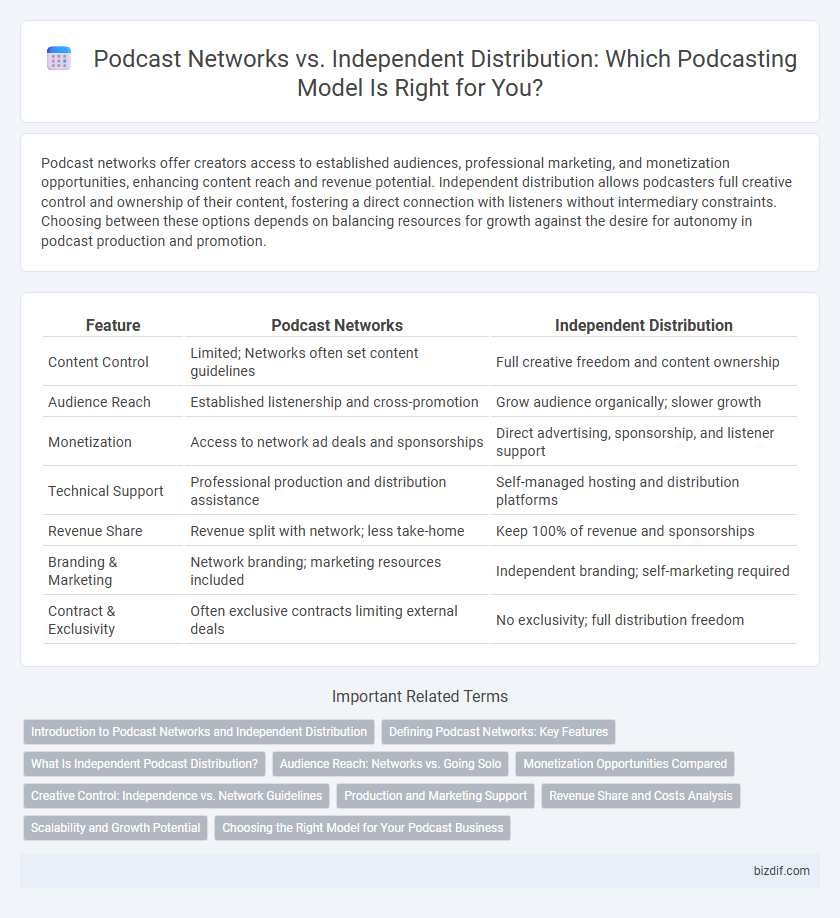Podcast networks offer creators access to established audiences, professional marketing, and monetization opportunities, enhancing content reach and revenue potential. Independent distribution allows podcasters full creative control and ownership of their content, fostering a direct connection with listeners without intermediary constraints. Choosing between these options depends on balancing resources for growth against the desire for autonomy in podcast production and promotion.
Table of Comparison
| Feature | Podcast Networks | Independent Distribution |
|---|---|---|
| Content Control | Limited; Networks often set content guidelines | Full creative freedom and content ownership |
| Audience Reach | Established listenership and cross-promotion | Grow audience organically; slower growth |
| Monetization | Access to network ad deals and sponsorships | Direct advertising, sponsorship, and listener support |
| Technical Support | Professional production and distribution assistance | Self-managed hosting and distribution platforms |
| Revenue Share | Revenue split with network; less take-home | Keep 100% of revenue and sponsorships |
| Branding & Marketing | Network branding; marketing resources included | Independent branding; self-marketing required |
| Contract & Exclusivity | Often exclusive contracts limiting external deals | No exclusivity; full distribution freedom |
Introduction to Podcast Networks and Independent Distribution
Podcast networks aggregate multiple shows under a single brand, offering shared resources like marketing, monetization, and audience growth tools to streamline distribution and increase reach. Independent distribution allows creators full control over their content, platforms, and revenue streams, leveraging services such as Apple Podcasts, Spotify, and RSS feeds to maintain direct relationships with listeners. Choosing between podcast networks and independent distribution impacts scalability, branding, and income potential in the podcasting ecosystem.
Defining Podcast Networks: Key Features
Podcast networks are collections of shows grouped under a unified brand, offering centralized marketing, advertising, and audience analytics to maximize reach and monetization. These networks typically provide resources such as production support, sponsorship deals, and cross-promotion opportunities, enhancing visibility for individual podcasts. Key features include aggregated audience data, shared technological infrastructure, and curated content strategies designed to attract niche or broad listener demographics.
What Is Independent Podcast Distribution?
Independent podcast distribution refers to podcasters publishing and managing their content without relying on major podcast networks or aggregators, allowing full control over monetization, branding, and audience engagement. This approach leverages platforms like RSS feeds, personal websites, and direct hosting services to disseminate episodes, ensuring flexibility in content delivery and data analytics. Independent distribution empowers creators to build direct relationships with listeners, retain ownership of their intellectual property, and adapt swiftly to evolving audience preferences and market trends.
Audience Reach: Networks vs. Going Solo
Podcast networks typically offer broader audience reach by leveraging shared marketing resources, cross-promotion, and established listener bases across multiple shows. Independent distribution allows creators to maintain full control over their content and branding but often requires more effort to organically grow an audience without the built-in amplification that networks provide. Data shows that podcasts within networks generally experience faster scalability in audience size, although niche podcasts with strong personal branding can achieve significant reach independently.
Monetization Opportunities Compared
Podcast networks often provide podcasters with enhanced monetization opportunities through established advertising partnerships and dynamic ad insertion technology, leading to higher revenue potential. Independent distribution allows creators to retain full control over their content and advertising strategies but may require more effort to secure sponsors and optimize revenue streams. Choosing between these models depends on balancing control with access to network-driven monetization resources.
Creative Control: Independence vs. Network Guidelines
Independent podcast distribution offers creators full creative control, allowing for unique content, niche topics, and flexible production schedules without external constraints. Podcast networks often impose specific guidelines, branding requirements, and content standards to maintain cohesion and audience appeal across their shows. Choosing between networks and independence depends on whether creative freedom or structured support aligns better with the podcast's goals and target audience.
Production and Marketing Support
Podcast networks provide extensive production resources including professional editing, sound design, and hosting platforms that streamline the creation process. They offer robust marketing support through established audience channels, advertising partnerships, and social media promotion. Independent distribution requires podcasters to manage all production elements and develop personalized marketing strategies, often demanding more time and expertise to build audience reach.
Revenue Share and Costs Analysis
Podcast networks typically offer higher revenue share percentages, often around 60-70%, but impose costs through network fees and limited control over monetization strategies. Independent distribution allows podcasters to retain up to 100% of their revenue while managing lower overhead costs, though it demands greater investment in marketing and sales efforts. Evaluating cost structures and revenue potential reveals that podcast networks provide streamlined monetization with shared profits, whereas independent distribution maximizes earnings at the expense of increased operational responsibilities.
Scalability and Growth Potential
Podcast networks offer scalable infrastructure and established audience bases, enabling creators to rapidly expand reach and monetize content more effectively. Independent distribution provides full control and flexibility but often requires significant self-promotion efforts and limited resources, potentially slowing growth. Leveraging a network can accelerate audience growth and sponsorship opportunities, while independence favors personalized branding and niche market targeting.
Choosing the Right Model for Your Podcast Business
Podcast networks provide established distribution channels, marketing resources, and monetization opportunities but often require sharing revenue and limited creative control. Independent distribution offers full ownership, direct audience engagement, and flexible monetization strategies, though it demands higher effort in marketing and platform management. Evaluating goals, resources, and desired control helps podcasters select the optimal model to maximize reach and profitability.
Podcast Networks vs Independent Distribution Infographic

 bizdif.com
bizdif.com